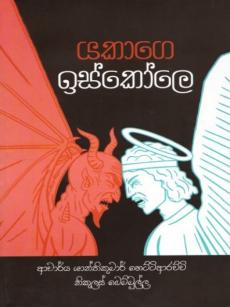Ceylon Today Features (25 June 2017)
By Priyangwada Perera

Generations of readers have been allowed inside various schools without official admission. That is because authors have collected their memoirs as students and written beautiful texts. Stories are of different kinds. These school stories are undoubtedly entertaining. Yet, oblivious to the writers the stories also end up being chronicles. They provide much insight into the life and times. The latest such is co-authored by Dr. Shanthikumar Hettiarachchi and Nicholas Bemmulla. The book is ambiguously titled Yakage Iskole – the Devil’s School.
During the colonial days, imparting knowledge or education was mostly the privilege of the missionaries. Formal learning was largely a luxury reserved for a selected few in society. Pamunugama was predominantly a Catholic community. They were very devout in their associations with the Church. At the time there were two schools where the medium of education was Sinhala. One was for boys and the other was for girls. The book reveals that in the territory marked by the Pitipana bridge and the Kelani bridge, no school offered English medium education. When Pamunugama Maha Vidyalaya was founded in 1946, making education accessible to all, it caused a huge crack in this hierarchy.
In the mid 1940s the people of Bopitiya requested the Government of Ceylon for an English medium school for the people of Bopitiya. As expected this did not please the richer people in the local community. These were the people who had their own children studying in the best colleges in Colombo. As unfortunate as it may sound, the Church spoke against the request of the people. Not only did the Church speak against the school and criticize it during mass, some Catholics who took the initiative to start the school were accused by the Church. The rich and the Church held hands in protest at the emergence of the new school. Because of the strong antipathy and exclusion by the Church, Pamunugama Maha Vidyala was ‘christened’ Yakage Iskole, or the Devil’s School. However, a certain set of elites in the village recognized the importance of having such a school. Powered and enlightened by the new nationalistic awakening that was happening in the country, certain philanthropists took matters into their hands. Led by the initiative of Victor Jayamaha, a group of gentlemen in the likes of Martin Jayamaha, Hector Jayamaha, K. D. Joseph, P. V. Fernando, Francis Jayamaha and P.C.B. Perera become the forefathers of Pamunugama Maha Vidyalaya.
The guest speaker at the book launch was Upulshantha Sannasgala who was a brilliant combination of facts and humour. Drawing parallels with a similar novel he had written long years back about the transformation of his own school in Diyatalawa, the speech was an exploration of the various stages of schools in the country. Sannasgala mainly focused on how in most of these instances, one educator of gut and nerve could recuperate an entire generation.
A note was made of the students of the school and how well they have done in all walks of life. The first female student of this school was Amitha Jayamanna. Pamunugama Maha Vidyalaya claims credit for a galaxy of star students. From actor/singer Rodney Warnakula to academics like Professor of Biology, University of Colombo, Barlo Daya the school has seen the blooming of talented village children. Dr. Shanthi Kumar Hettiarachchi and Nicholas Bemmulla have brought this chronicle to life. It is both a bold and candid attempt to look into things as they were. Bold and candid because there is no attempt to white-wash anyone or any institution. At the same time, the book is not a lasso to drag the old injustices on stage. It is simply the story of a village that found its voice for the benefit of many. It is a fine tale of how education was made available to the masses. It is a tale of heroism where people did not bend their heads when the institutional representation of religion was far from fair. Dr. Shanthi Kumar explained their motives for releasing such a book. “It is to correct the misconceptions, to honour the past pupils and also to try and convince the Church that they should apologize for their once-upon-a time rigidity.”

